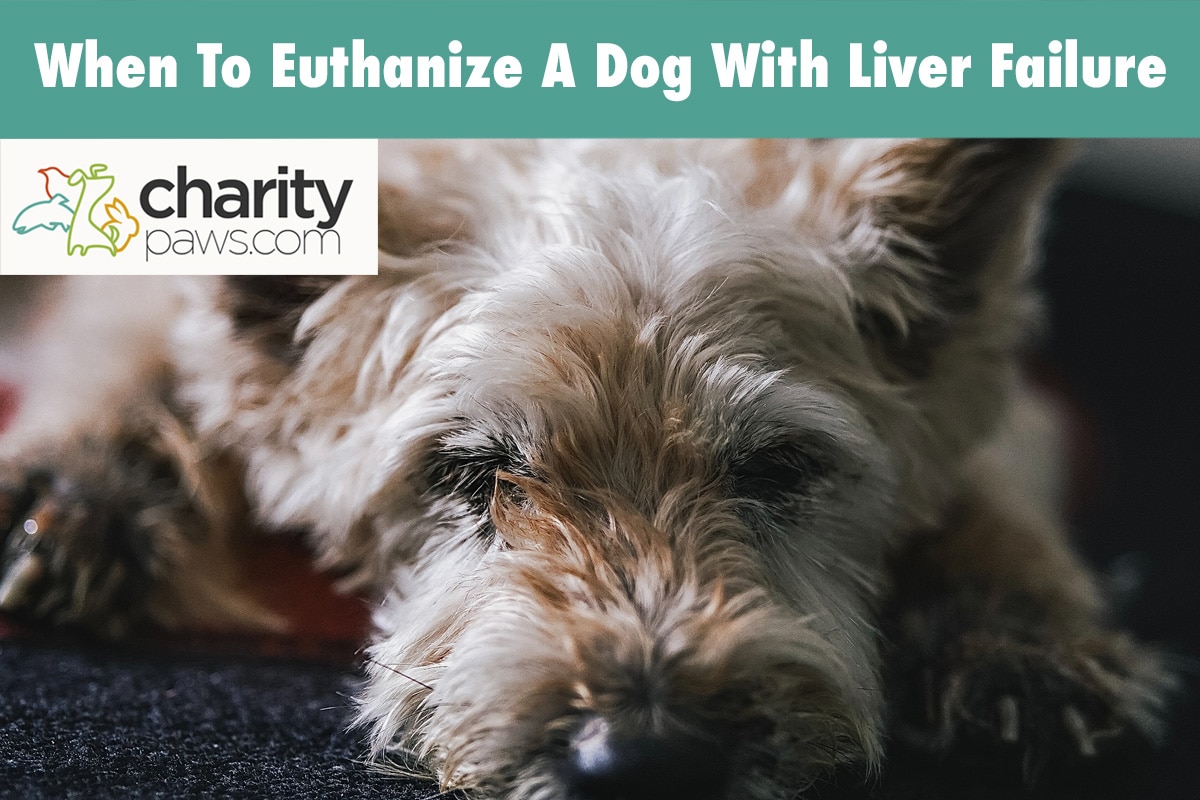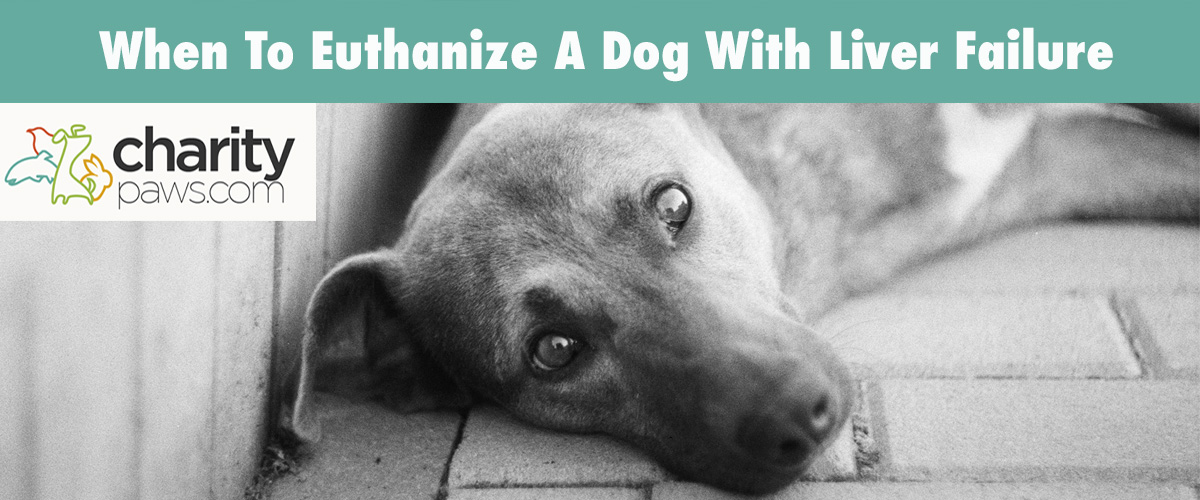If you have a canine companion that was recently diagnosed with liver disease, you may wonder what this means for their future.
Liver disease is a life-altering condition that can develop due to a number of causes, and will gradually lead to the ultimate failure of the organ.
You may be aware that their condition will eventually progress into liver failure, but how can you know when your dog has reached the point of suffering?
In this article we will discuss the many details of liver failure in dogs, and help you better understand when it may be time to euthanize your dog with liver failure.

What Is Liver Disease In Dogs?
Just like in humans, the liver plays a vital role in multiple body processes in the canine body.
The liver is responsible for proper digestion and conversion of food, maintaining blood clotting and immunity abilities, storing glucose, and even breaking down toxic substances.
With seeing these functions laid out, you can understand just how serious it is when the liver is damaged in any way.
The liver does a wonderful job of repairing itself against minor ailments, but there are certain impacts that can lead to lasting liver damage over time.
If any of the below factors cause significant damage to the organ, the dog may develop liver disease and ultimate failure as it progresses.
Some of the most common causes of liver disease or liver failure in dogs include:
- Viral or bacterial infections
- Trauma to the liver itself (such as a serious road traffic accident)
- Endocrine diseases like diabetes and Cushing’s disease
- Heat stroke
- Immune disease
- Cancer
- Toxin ingestions that impact the liver
- Congenital liver conditions
Chronic liver disease in dogs refers to the damage of the liver over time, leading to ultimate failure as the condition progresses.
Liver disease is often referred to as either chronic or acute, with the acute disease referring to a sudden liver injury of some kind.
This could include trauma, infections, heat stroke, or even toxin ingestion.
What Is Considered Liver Failure In Dogs?
The terms liver disease and liver failure are often used interchangeably, so it can be challenging to understand the differences.
The term liver disease refers to a condition that causes long term inflammation or damage to the liver over time, while the term liver failure refers to any decline or failure in liver function.
Over 75% of the liver typically has to be damaged for actual liver failure to occur, so a dog can have liver disease for a significant amount of time before liver failure actually occurs.
However, if acute damage is severe enough, the organ can fail as a result of a sudden organ injury.
We know it’s confusing, but just remember that if your veterinarian diagnoses your dog with liver failure, this means that their liver has been damaged to the point of partial or complete failure.
This can make it difficult for the liver to carry out vital body functions which can ultimately be fatal for some furry friends.
What Are The Signs Of Liver Failure In Dogs?
As we discussed above, the canine liver plays a role in an array of important bodily functions.
Due to this, the onset of liver failure can lead to an array of concerning symptoms for the dog affected.
Some of the most common signs of liver failure in dogs include:
- Decrease in appetite or anorexia
- Lethargy
- Increased thirst
- Increased urination
- Vomiting
- Diarrhea, with or without blood in the stool
- Distended abdomen as a result of fluid accumulation
- Weight loss
- Yellowing of the skin, eyes, gums, or other mucus membranes (jaundice)
If you notice any of the above symptoms in your dog, we suggest having them seen immediately by a vet.
If your vet fears liver disease or failure in your pup, they will likely perform a series of diagnostics to get some answers.
How To Diagnose Liver Failure In Dogs
If your vet is suspicious of liver failure in your beloved pup, they will likely suggest a few tests that can offer some answers.
First, your vet will start by performing a physical exam and obtaining a thorough history.
This will involve taking their vitals and asking questions about their symptoms at home, which allows them to paint a clear picture on what the dog is experiencing.
They will also ask you about any potential for toxicity, injury, or illness that is present, as these complications can lead to sudden liver failure.
Once they complete the initial exam, your vet will move on to diagnostics.
Liver failure can be suspected with blood tests alone, but it is also ideal to perform an abdominal ultrasound and fine needle aspirate or a biopsy of the liver to try and work out what has caused the problem.
Sometimes this biopsy can diagnose the exact cause of the dog’s liver failure, but that’s not always the case if the original cause is no longer detectable.
Different Stages Of Liver Failure In Dogs
Once your dog’s liver begins to fail, there are typically a few different stages that the organ will move through on the way to end-stage failure.
Let’s break down each stage in detail below.
Early Stages Of Liver Failure In Dogs
In the early stages of liver failure in dogs, their liver has typically just begun to fail.
They will likely still have some organ functionality, so you may just see general signs of your pup feeling unwell.
This could include a decrease in appetite, slight lethargy, increased naps each day, and even the occasional nausea and vomiting.
If your dog’s liver failure is caught in this stage, many times you can slow the progression of the disease with prescription diets, medications and close monitoring.
This is why it is so important to reach out to your vet anytime your pup is feeling under the weather, as it could be an early sign of something serious.
Middle Stages Of Liver Failure In Dogs
By the time the dog has reached the middle stage of liver failure, you will begin to notice more severe symptoms and changes in behavior.
A significant amount of liver function has been lost at this point, causing a slew of complications to develop behind the scenes.
Dogs in the middle stage of liver disease may experience:
- Anorexia
- Vomiting
- Diarrhea
- Lethargy
- Pot-bellied appearance
- Jaundice
- Slight changes in their normal personality
Their body is really struggling to keep up with the decline in liver function at this point, so the changes in your pup will be obvious.
It is much more challenging to slow the progression of their liver failure once they have reached this point, but it is still important to seek veterinary care.
If anything, your vet can make your pup more comfortable as their disease progresses.
End Stage Liver Failure In Dogs
By the time your dog reaches end-stage liver failure, they have lost at least 75% of their liver function abilities. Once below 20% functionality, the disease becomes terminal.
In addition to the symptoms we listed above, many dogs will develop a significant decline in their mentation and cognitive functions.
This is a result of the toxin buildup in the bloodstream, leading to ultimate neurological complications for the affected pup.
The toxin buildup in the bloodstream that causes neurological symptoms is referred to as hepatic encephalopathy.
In addition to the threat of hepatic encephalopathy is the risk of internal bleeding in end-stage liver failure.
The liver plays a vital role in helping the body produce clotting factors, so the inability to carry out this task increases the risk of bleeding.
Overall, your dog in end stage liver failure will be in a critical state.
Can You Treat Liver Failure In Dogs?
Any treatment of liver failure in dogs will just be a bandaid, but it can potentially slow the progression of their disease.
You cannot reverse the damage to the liver once it has progressed into liver failure, but you may be able to offer your pup more time with treatment.
This is most effective when you intervene during the first stages of liver failure.
First, if your dog is in a critical state, your vet may be able to hospitalize them and pull them out of crisis mode.
This will involve fluid administration and medication that eliminates toxins, as this could offer the organ proper rest.
If this option is successful, it could buy your pup some more time.
If your dog is not yet in a critical state, there are a few treatment options that may prolong your dog’s life.
These options include prescription diets that are easier for the liver to break down, supplements that help to eliminate toxins, medications to control nausea and stimulate an appetite, and restricted physical activity.
These options will not reverse the damage that has been done to the liver, but it can offer them more time before the organ fails completely.
How Long Can A Dog Live With Liver Failure?
If your dog has just been diagnosed with liver failure, you are likely wondering how much time they have left.
Though every case will vary, there is an average life expectancy based on the stage of their liver failure.
If you caught your dog’s liver failure in the first stage and you implemented treatment, your pup may have anywhere from 6 months to 3 years.
Though you cannot reverse any damage that occurred before diagnosis, you can certainly slow the progression of their disease with proper management.
Things get a bit more complicated if they are diagnosed in the middle or end stage of their liver failure.
If your dog has lost a significant amount of their liver function, their survival time will likely be much shorter.
Treatment is still recommended for dogs that are not yet suffering, but they may only have anywhere from a few weeks to 6 months.
This general survival time refers to dogs that have not yet developed hepatic encephalopathy or clotting disorders.
If your dog has developed bleeding complications or neurological symptoms, their condition is considered critical.
These pups may not be able to pursue treatment moving forward, or they may only have a few days or weeks ahead of them.
Your vet will likely discuss the possibility of euthanasia in these situations.
Can A Dog Live With Hepatic Encephalopathy?
A dog’s survival rate with hepatic encephalopathy will vary based on how severe their condition is.
For example, a dog with mental dullness will have a much more positive prognosis than a dog experiencing seizures and collapse, as this is an indicator of how much damage has been done to the body.
The only way dogs with hepatic encephalopathy can survive is if they receive aggressive and immediate treatment.
This condition can lead to severe neurological symptoms and brain damage that is irreversible, so your veterinary team will need to intervene immediately.
If your dog can be pulled out of their aggressive state, they still have a poor prognosis as far as survival time moving forward.
Many owners make the decision to put their dog to sleep if they develop hepatic encephalopathy, as this is a sign of end stage liver failure.
If this occurs in your canine companion, your vet will likely have a quality of life discussion with you.
Is Liver Failure Painful In Dogs?
Many of us have heard of liver failure being painful in humans, so naturally we assume the same in dogs.
While our beloved pups can’t tell us how they are feeling each day, we can observe their behavior for any signs of pain.
If your dog is experiencing anorexia, lethargy, a distended abdomen, personality changes, or digestive upset, this could be their way of telling you they are uncomfortable.
In these situations, we suggest reaching out to your vet to see if there are any treatment options that can alleviate these symptoms.
Is My Dog With Liver Failure Suffering?
We never want our dogs to suffer, so it’s important to be aware of the potential signs of pain and discomfort in dogs with liver failure.
These symptoms can help you make the decision on whether or not to continue with treatment for your pup, or if it may be time to say goodbye.
A dog with liver disease may be suffering in their condition if they are experiencing the following symptoms:
- No longer eating
- Chronic vomiting or diarrhea
- Fluid in the abdomen causing a pot-bellied appearance
- Chronic lethargy
- Disinterest in things they once enjoyed
- Significant weight loss
- Dull mentation
- Confusion or disorientation
- Muscle tremors
- Increased vocalizations
- Seizures
- Coma
If your dog is experiencing any of the above symptoms, it may be their way of telling you they are tired and ready to give up their fight.
You can still speak with your vet about whether or not any options are available, but a quality of life discussion is only completely valid.
No matter what stage of liver failure your dog is in, euthanasia is always a kind decision that you should not feel guilt over.
Many owners make the choice to say goodbye to their pups before they reach the point of suffering, as this is their way of preventing any pain to come.
Liver failure is always fatal, so we urge you to avoid putting the burden of guilt on your shoulders.
When To Euthanize A Dog With Liver Failure

If your dog is experiencing any of the symptoms we listed above, and it seems like they are having more bad days then good, it may be time to discuss saying goodbye to your dog with liver failure.
Treatment will only offer your pup a bandaid, so choosing euthanasia in these situations is a kind option that many owners explore.
You know your dog best, so if you think they have begun to suffer, we always suggest having an end of life discussion with your vet.
They will help to guide you in the best direction for your pup, and offer you the much needed support you deserve during this time.
FAQs
Can toxicities lead to liver failure in dogs?
Yes, toxicities can lead to acute liver failure in dogs.
Some of the most common toxicities that impact the liver include:
- Xylitol (an artificial sweetener found in many products)
- Medications e.g. Tylenol
- Moldy food
- Certain toxic mushrooms
- Toxic plants e.g. sago palm
- Blue-green algae
This is why it is so important to keep any potential toxins away from your pup, as well as being aware of the potential toxic substances in your home.
My dog with liver failure won’t eat, what can I do?
If your dog with liver failure won’t eat, we suggest reaching out to your vet for an appetite stimulant.
If this still doesn’t help your pup, you can speak with your vet about any homemade meal options that you can offer your pup.
Sometimes a change in food can be exciting enough to encourage your dog to eat.
Some of the favorite options for dogs include boiled chicken, boiled turkey, and even eggs.
What is the best diet for my dog with liver disease?
If your dog is in the early stages of their disease and still has an appetite, we suggest speaking with your vet about prescription diets for liver disease.
These diets are formulated to be easy on the liver, and they come in either dry kibble or canned options.
Is there a cure for liver failure?
There is no cure for liver failure, as the damage to the liver cannot be reversed.
However, there are ways to slow the progression of their disease.
We suggest speaking with your vet about prescription diets, liver support supplements, and any other options that support your dog’s specific case.

